ENV513: Environmental Policy and Planning in Australia - Analysis
VerifiedAdded on 2022/08/26
|9
|2029
|15
Essay
AI Summary
This essay provides a comprehensive overview of environmental policies and planning in Australia, exploring the definition of environmental policy and its significance in addressing environmental issues. It delves into the various policies and practices implemented by the Australian government to promote environmental sustainability, including sustainable building designs and business development initiatives. The paper outlines the policy cycle, detailing its importance in environmental policy and climate change management, and discusses the approaches used in environmental management, such as those employed by the Human Services Department. It also examines the drivers of environmental change, differentiating between direct and indirect drivers like population growth and land use, and highlights the impact of climate variability and fragmentation. The essay concludes by emphasizing the role of environmental policy and planning in providing frameworks to address environmental problems and achieve sustainable outcomes, supported by social, natural, and economic factors. The paper also references various environmental organizations and the environmental sustainability index, providing a global perspective on Australia's environmental performance.
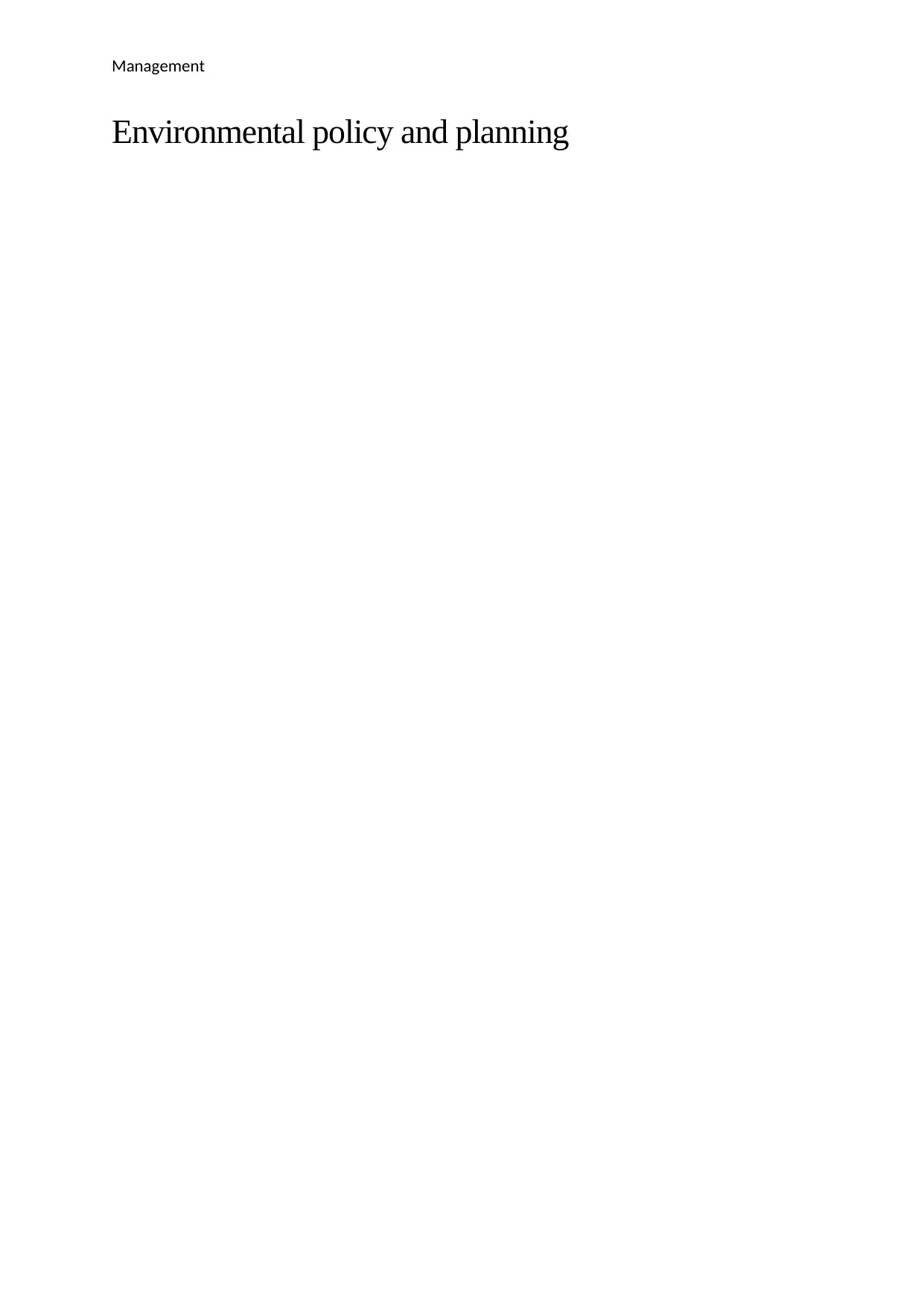
Management
Environmental policy and planning
Environmental policy and planning
Paraphrase This Document
Need a fresh take? Get an instant paraphrase of this document with our AI Paraphraser
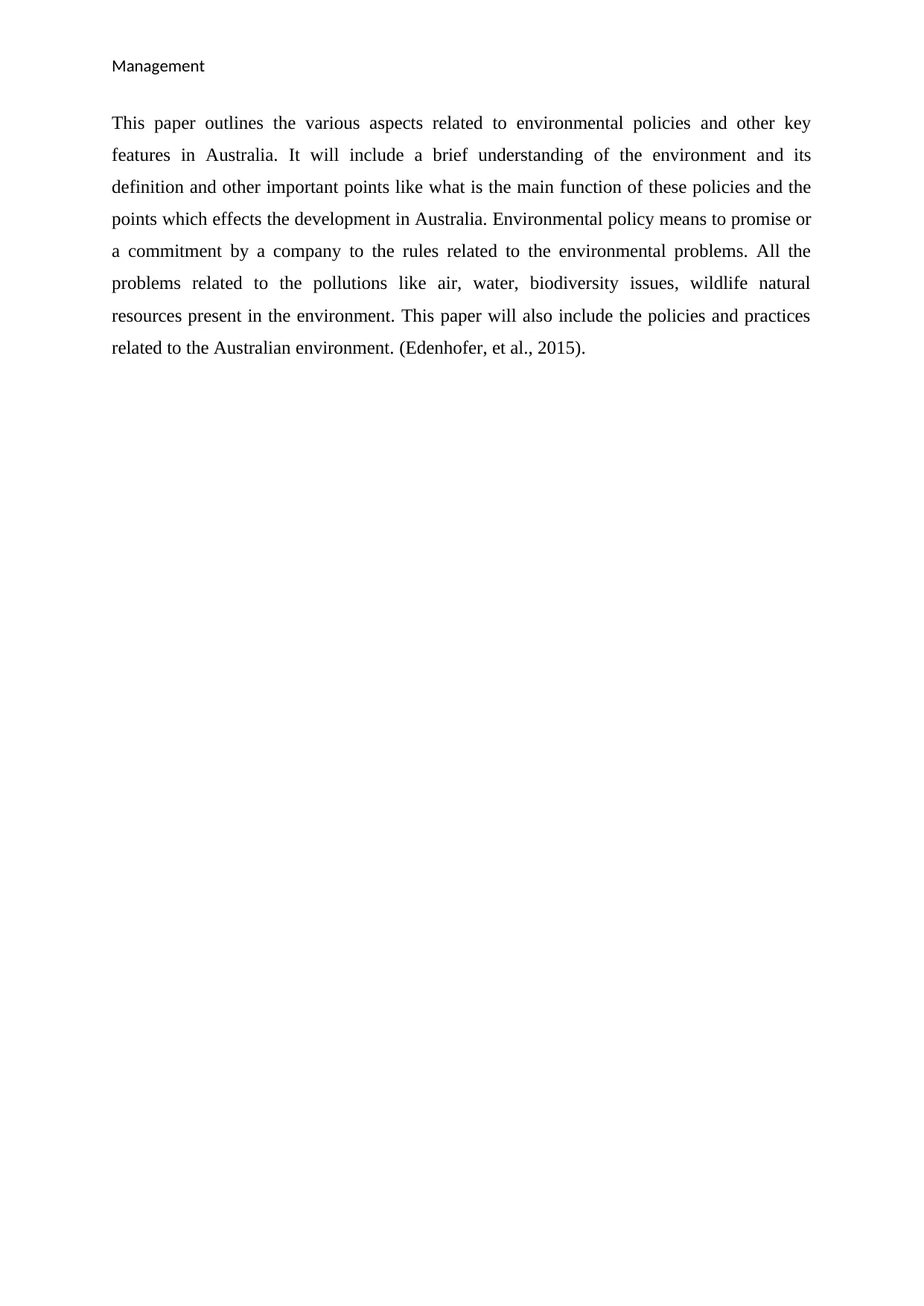
Management
This paper outlines the various aspects related to environmental policies and other key
features in Australia. It will include a brief understanding of the environment and its
definition and other important points like what is the main function of these policies and the
points which effects the development in Australia. Environmental policy means to promise or
a commitment by a company to the rules related to the environmental problems. All the
problems related to the pollutions like air, water, biodiversity issues, wildlife natural
resources present in the environment. This paper will also include the policies and practices
related to the Australian environment. (Edenhofer, et al., 2015).
This paper outlines the various aspects related to environmental policies and other key
features in Australia. It will include a brief understanding of the environment and its
definition and other important points like what is the main function of these policies and the
points which effects the development in Australia. Environmental policy means to promise or
a commitment by a company to the rules related to the environmental problems. All the
problems related to the pollutions like air, water, biodiversity issues, wildlife natural
resources present in the environment. This paper will also include the policies and practices
related to the Australian environment. (Edenhofer, et al., 2015).
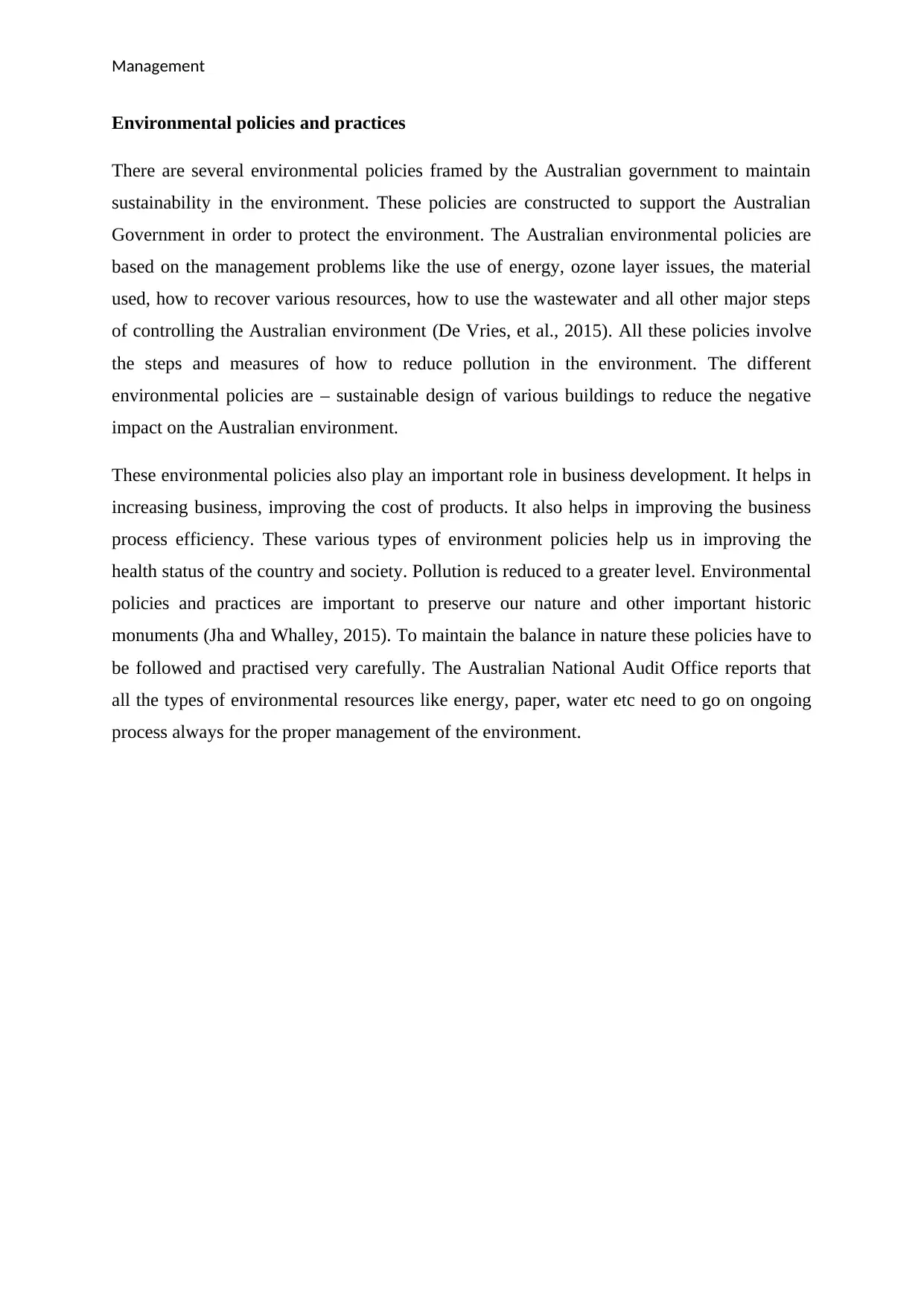
Management
Environmental policies and practices
There are several environmental policies framed by the Australian government to maintain
sustainability in the environment. These policies are constructed to support the Australian
Government in order to protect the environment. The Australian environmental policies are
based on the management problems like the use of energy, ozone layer issues, the material
used, how to recover various resources, how to use the wastewater and all other major steps
of controlling the Australian environment (De Vries, et al., 2015). All these policies involve
the steps and measures of how to reduce pollution in the environment. The different
environmental policies are – sustainable design of various buildings to reduce the negative
impact on the Australian environment.
These environmental policies also play an important role in business development. It helps in
increasing business, improving the cost of products. It also helps in improving the business
process efficiency. These various types of environment policies help us in improving the
health status of the country and society. Pollution is reduced to a greater level. Environmental
policies and practices are important to preserve our nature and other important historic
monuments (Jha and Whalley, 2015). To maintain the balance in nature these policies have to
be followed and practised very carefully. The Australian National Audit Office reports that
all the types of environmental resources like energy, paper, water etc need to go on ongoing
process always for the proper management of the environment.
Environmental policies and practices
There are several environmental policies framed by the Australian government to maintain
sustainability in the environment. These policies are constructed to support the Australian
Government in order to protect the environment. The Australian environmental policies are
based on the management problems like the use of energy, ozone layer issues, the material
used, how to recover various resources, how to use the wastewater and all other major steps
of controlling the Australian environment (De Vries, et al., 2015). All these policies involve
the steps and measures of how to reduce pollution in the environment. The different
environmental policies are – sustainable design of various buildings to reduce the negative
impact on the Australian environment.
These environmental policies also play an important role in business development. It helps in
increasing business, improving the cost of products. It also helps in improving the business
process efficiency. These various types of environment policies help us in improving the
health status of the country and society. Pollution is reduced to a greater level. Environmental
policies and practices are important to preserve our nature and other important historic
monuments (Jha and Whalley, 2015). To maintain the balance in nature these policies have to
be followed and practised very carefully. The Australian National Audit Office reports that
all the types of environmental resources like energy, paper, water etc need to go on ongoing
process always for the proper management of the environment.
⊘ This is a preview!⊘
Do you want full access?
Subscribe today to unlock all pages.

Trusted by 1+ million students worldwide
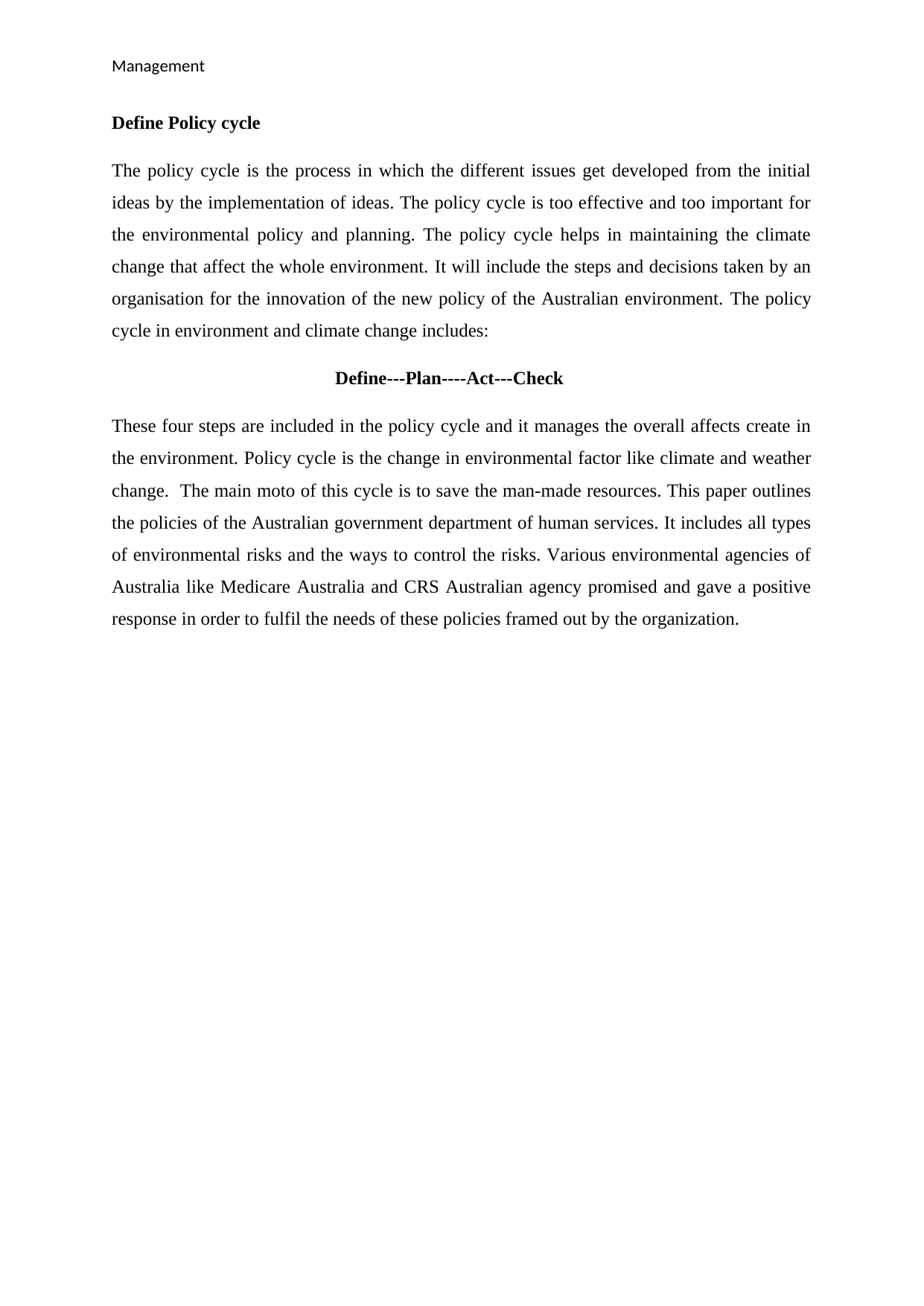
Management
Define Policy cycle
The policy cycle is the process in which the different issues get developed from the initial
ideas by the implementation of ideas. The policy cycle is too effective and too important for
the environmental policy and planning. The policy cycle helps in maintaining the climate
change that affect the whole environment. It will include the steps and decisions taken by an
organisation for the innovation of the new policy of the Australian environment. The policy
cycle in environment and climate change includes:
Define---Plan----Act---Check
These four steps are included in the policy cycle and it manages the overall affects create in
the environment. Policy cycle is the change in environmental factor like climate and weather
change. The main moto of this cycle is to save the man-made resources. This paper outlines
the policies of the Australian government department of human services. It includes all types
of environmental risks and the ways to control the risks. Various environmental agencies of
Australia like Medicare Australia and CRS Australian agency promised and gave a positive
response in order to fulfil the needs of these policies framed out by the organization.
Define Policy cycle
The policy cycle is the process in which the different issues get developed from the initial
ideas by the implementation of ideas. The policy cycle is too effective and too important for
the environmental policy and planning. The policy cycle helps in maintaining the climate
change that affect the whole environment. It will include the steps and decisions taken by an
organisation for the innovation of the new policy of the Australian environment. The policy
cycle in environment and climate change includes:
Define---Plan----Act---Check
These four steps are included in the policy cycle and it manages the overall affects create in
the environment. Policy cycle is the change in environmental factor like climate and weather
change. The main moto of this cycle is to save the man-made resources. This paper outlines
the policies of the Australian government department of human services. It includes all types
of environmental risks and the ways to control the risks. Various environmental agencies of
Australia like Medicare Australia and CRS Australian agency promised and gave a positive
response in order to fulfil the needs of these policies framed out by the organization.
Paraphrase This Document
Need a fresh take? Get an instant paraphrase of this document with our AI Paraphraser
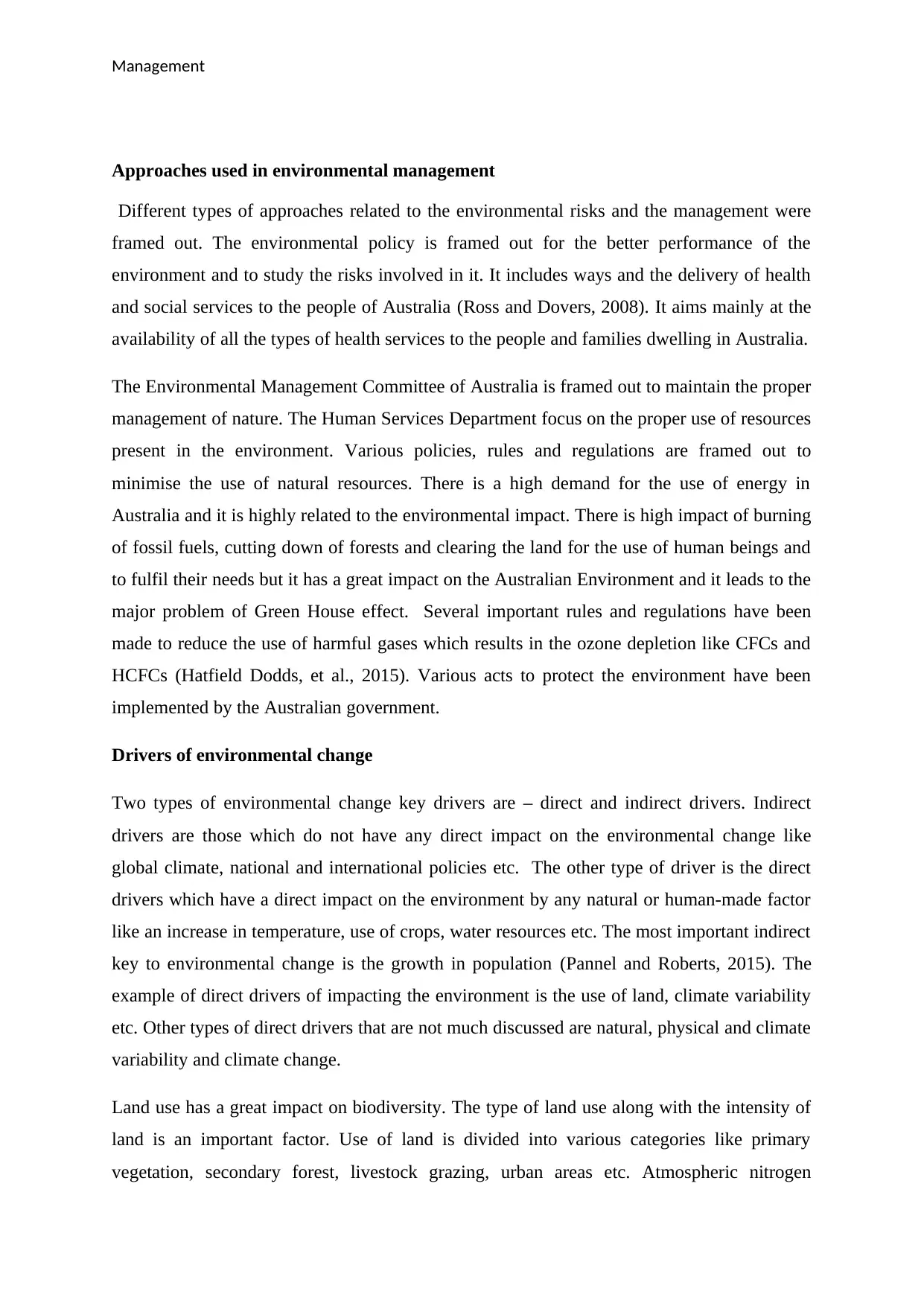
Management
Approaches used in environmental management
Different types of approaches related to the environmental risks and the management were
framed out. The environmental policy is framed out for the better performance of the
environment and to study the risks involved in it. It includes ways and the delivery of health
and social services to the people of Australia (Ross and Dovers, 2008). It aims mainly at the
availability of all the types of health services to the people and families dwelling in Australia.
The Environmental Management Committee of Australia is framed out to maintain the proper
management of nature. The Human Services Department focus on the proper use of resources
present in the environment. Various policies, rules and regulations are framed out to
minimise the use of natural resources. There is a high demand for the use of energy in
Australia and it is highly related to the environmental impact. There is high impact of burning
of fossil fuels, cutting down of forests and clearing the land for the use of human beings and
to fulfil their needs but it has a great impact on the Australian Environment and it leads to the
major problem of Green House effect. Several important rules and regulations have been
made to reduce the use of harmful gases which results in the ozone depletion like CFCs and
HCFCs (Hatfield Dodds, et al., 2015). Various acts to protect the environment have been
implemented by the Australian government.
Drivers of environmental change
Two types of environmental change key drivers are – direct and indirect drivers. Indirect
drivers are those which do not have any direct impact on the environmental change like
global climate, national and international policies etc. The other type of driver is the direct
drivers which have a direct impact on the environment by any natural or human-made factor
like an increase in temperature, use of crops, water resources etc. The most important indirect
key to environmental change is the growth in population (Pannel and Roberts, 2015). The
example of direct drivers of impacting the environment is the use of land, climate variability
etc. Other types of direct drivers that are not much discussed are natural, physical and climate
variability and climate change.
Land use has a great impact on biodiversity. The type of land use along with the intensity of
land is an important factor. Use of land is divided into various categories like primary
vegetation, secondary forest, livestock grazing, urban areas etc. Atmospheric nitrogen
Approaches used in environmental management
Different types of approaches related to the environmental risks and the management were
framed out. The environmental policy is framed out for the better performance of the
environment and to study the risks involved in it. It includes ways and the delivery of health
and social services to the people of Australia (Ross and Dovers, 2008). It aims mainly at the
availability of all the types of health services to the people and families dwelling in Australia.
The Environmental Management Committee of Australia is framed out to maintain the proper
management of nature. The Human Services Department focus on the proper use of resources
present in the environment. Various policies, rules and regulations are framed out to
minimise the use of natural resources. There is a high demand for the use of energy in
Australia and it is highly related to the environmental impact. There is high impact of burning
of fossil fuels, cutting down of forests and clearing the land for the use of human beings and
to fulfil their needs but it has a great impact on the Australian Environment and it leads to the
major problem of Green House effect. Several important rules and regulations have been
made to reduce the use of harmful gases which results in the ozone depletion like CFCs and
HCFCs (Hatfield Dodds, et al., 2015). Various acts to protect the environment have been
implemented by the Australian government.
Drivers of environmental change
Two types of environmental change key drivers are – direct and indirect drivers. Indirect
drivers are those which do not have any direct impact on the environmental change like
global climate, national and international policies etc. The other type of driver is the direct
drivers which have a direct impact on the environment by any natural or human-made factor
like an increase in temperature, use of crops, water resources etc. The most important indirect
key to environmental change is the growth in population (Pannel and Roberts, 2015). The
example of direct drivers of impacting the environment is the use of land, climate variability
etc. Other types of direct drivers that are not much discussed are natural, physical and climate
variability and climate change.
Land use has a great impact on biodiversity. The type of land use along with the intensity of
land is an important factor. Use of land is divided into various categories like primary
vegetation, secondary forest, livestock grazing, urban areas etc. Atmospheric nitrogen
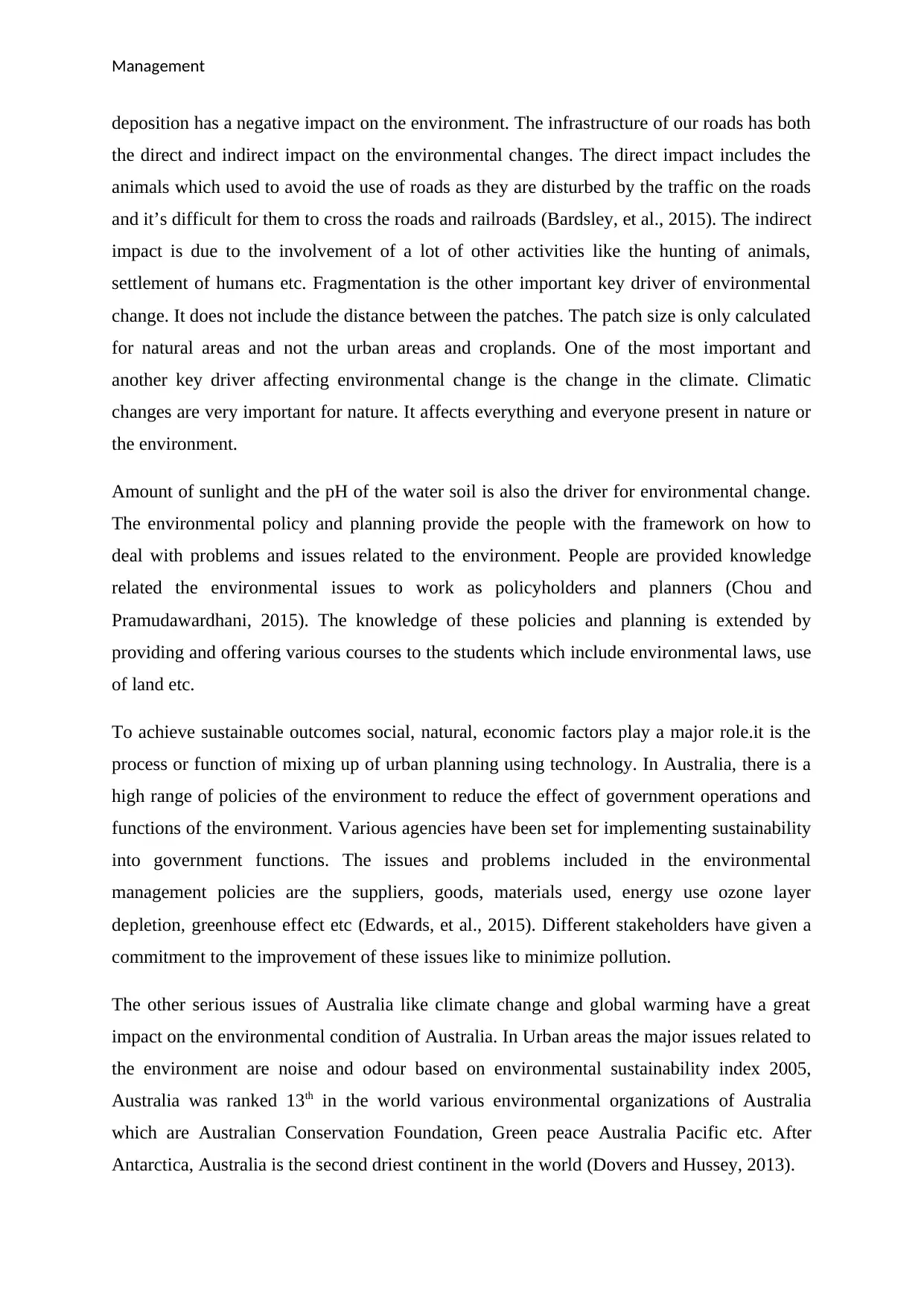
Management
deposition has a negative impact on the environment. The infrastructure of our roads has both
the direct and indirect impact on the environmental changes. The direct impact includes the
animals which used to avoid the use of roads as they are disturbed by the traffic on the roads
and it’s difficult for them to cross the roads and railroads (Bardsley, et al., 2015). The indirect
impact is due to the involvement of a lot of other activities like the hunting of animals,
settlement of humans etc. Fragmentation is the other important key driver of environmental
change. It does not include the distance between the patches. The patch size is only calculated
for natural areas and not the urban areas and croplands. One of the most important and
another key driver affecting environmental change is the change in the climate. Climatic
changes are very important for nature. It affects everything and everyone present in nature or
the environment.
Amount of sunlight and the pH of the water soil is also the driver for environmental change.
The environmental policy and planning provide the people with the framework on how to
deal with problems and issues related to the environment. People are provided knowledge
related the environmental issues to work as policyholders and planners (Chou and
Pramudawardhani, 2015). The knowledge of these policies and planning is extended by
providing and offering various courses to the students which include environmental laws, use
of land etc.
To achieve sustainable outcomes social, natural, economic factors play a major role.it is the
process or function of mixing up of urban planning using technology. In Australia, there is a
high range of policies of the environment to reduce the effect of government operations and
functions of the environment. Various agencies have been set for implementing sustainability
into government functions. The issues and problems included in the environmental
management policies are the suppliers, goods, materials used, energy use ozone layer
depletion, greenhouse effect etc (Edwards, et al., 2015). Different stakeholders have given a
commitment to the improvement of these issues like to minimize pollution.
The other serious issues of Australia like climate change and global warming have a great
impact on the environmental condition of Australia. In Urban areas the major issues related to
the environment are noise and odour based on environmental sustainability index 2005,
Australia was ranked 13th in the world various environmental organizations of Australia
which are Australian Conservation Foundation, Green peace Australia Pacific etc. After
Antarctica, Australia is the second driest continent in the world (Dovers and Hussey, 2013).
deposition has a negative impact on the environment. The infrastructure of our roads has both
the direct and indirect impact on the environmental changes. The direct impact includes the
animals which used to avoid the use of roads as they are disturbed by the traffic on the roads
and it’s difficult for them to cross the roads and railroads (Bardsley, et al., 2015). The indirect
impact is due to the involvement of a lot of other activities like the hunting of animals,
settlement of humans etc. Fragmentation is the other important key driver of environmental
change. It does not include the distance between the patches. The patch size is only calculated
for natural areas and not the urban areas and croplands. One of the most important and
another key driver affecting environmental change is the change in the climate. Climatic
changes are very important for nature. It affects everything and everyone present in nature or
the environment.
Amount of sunlight and the pH of the water soil is also the driver for environmental change.
The environmental policy and planning provide the people with the framework on how to
deal with problems and issues related to the environment. People are provided knowledge
related the environmental issues to work as policyholders and planners (Chou and
Pramudawardhani, 2015). The knowledge of these policies and planning is extended by
providing and offering various courses to the students which include environmental laws, use
of land etc.
To achieve sustainable outcomes social, natural, economic factors play a major role.it is the
process or function of mixing up of urban planning using technology. In Australia, there is a
high range of policies of the environment to reduce the effect of government operations and
functions of the environment. Various agencies have been set for implementing sustainability
into government functions. The issues and problems included in the environmental
management policies are the suppliers, goods, materials used, energy use ozone layer
depletion, greenhouse effect etc (Edwards, et al., 2015). Different stakeholders have given a
commitment to the improvement of these issues like to minimize pollution.
The other serious issues of Australia like climate change and global warming have a great
impact on the environmental condition of Australia. In Urban areas the major issues related to
the environment are noise and odour based on environmental sustainability index 2005,
Australia was ranked 13th in the world various environmental organizations of Australia
which are Australian Conservation Foundation, Green peace Australia Pacific etc. After
Antarctica, Australia is the second driest continent in the world (Dovers and Hussey, 2013).
⊘ This is a preview!⊘
Do you want full access?
Subscribe today to unlock all pages.

Trusted by 1+ million students worldwide
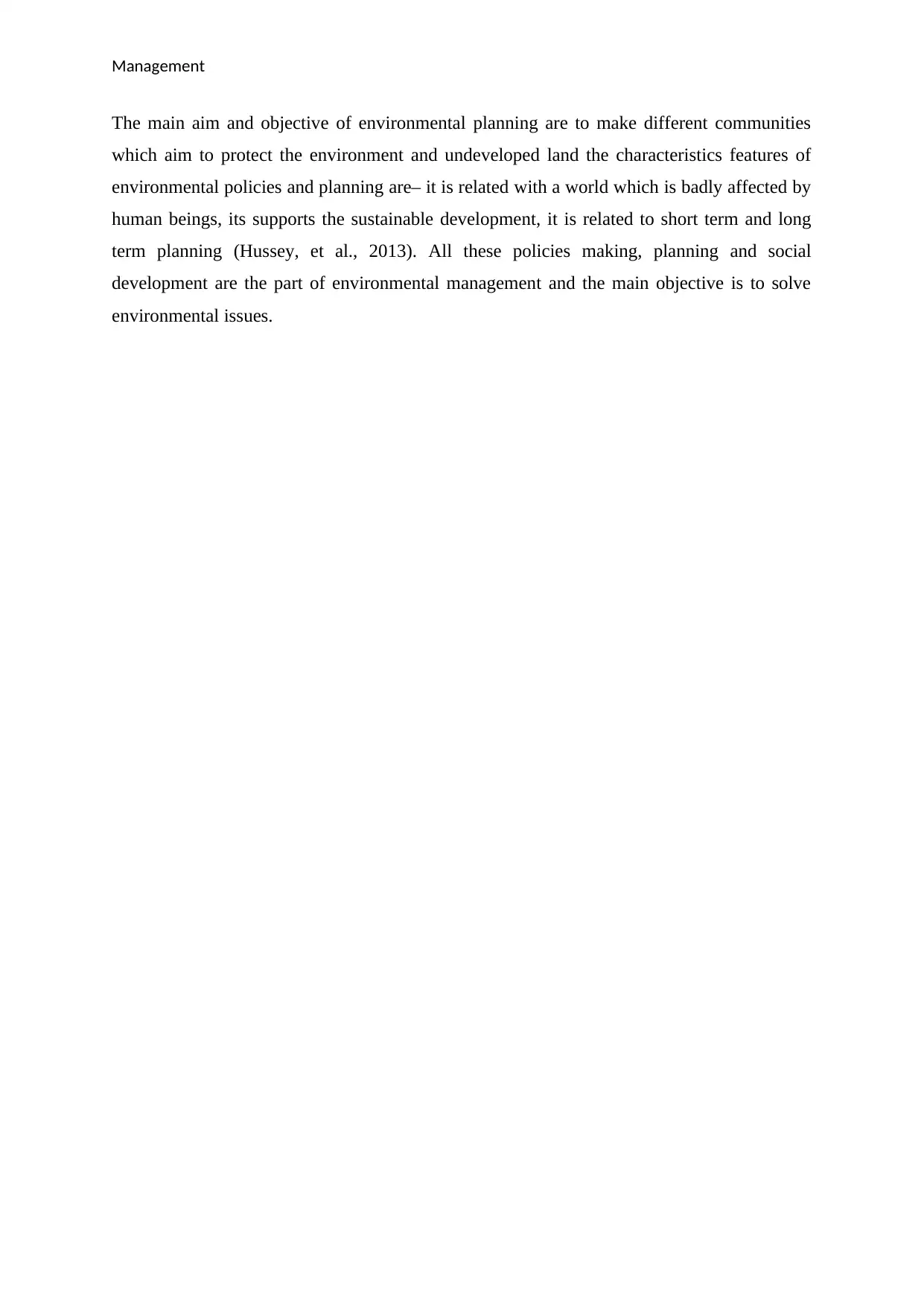
Management
The main aim and objective of environmental planning are to make different communities
which aim to protect the environment and undeveloped land the characteristics features of
environmental policies and planning are– it is related with a world which is badly affected by
human beings, its supports the sustainable development, it is related to short term and long
term planning (Hussey, et al., 2013). All these policies making, planning and social
development are the part of environmental management and the main objective is to solve
environmental issues.
The main aim and objective of environmental planning are to make different communities
which aim to protect the environment and undeveloped land the characteristics features of
environmental policies and planning are– it is related with a world which is badly affected by
human beings, its supports the sustainable development, it is related to short term and long
term planning (Hussey, et al., 2013). All these policies making, planning and social
development are the part of environmental management and the main objective is to solve
environmental issues.
Paraphrase This Document
Need a fresh take? Get an instant paraphrase of this document with our AI Paraphraser
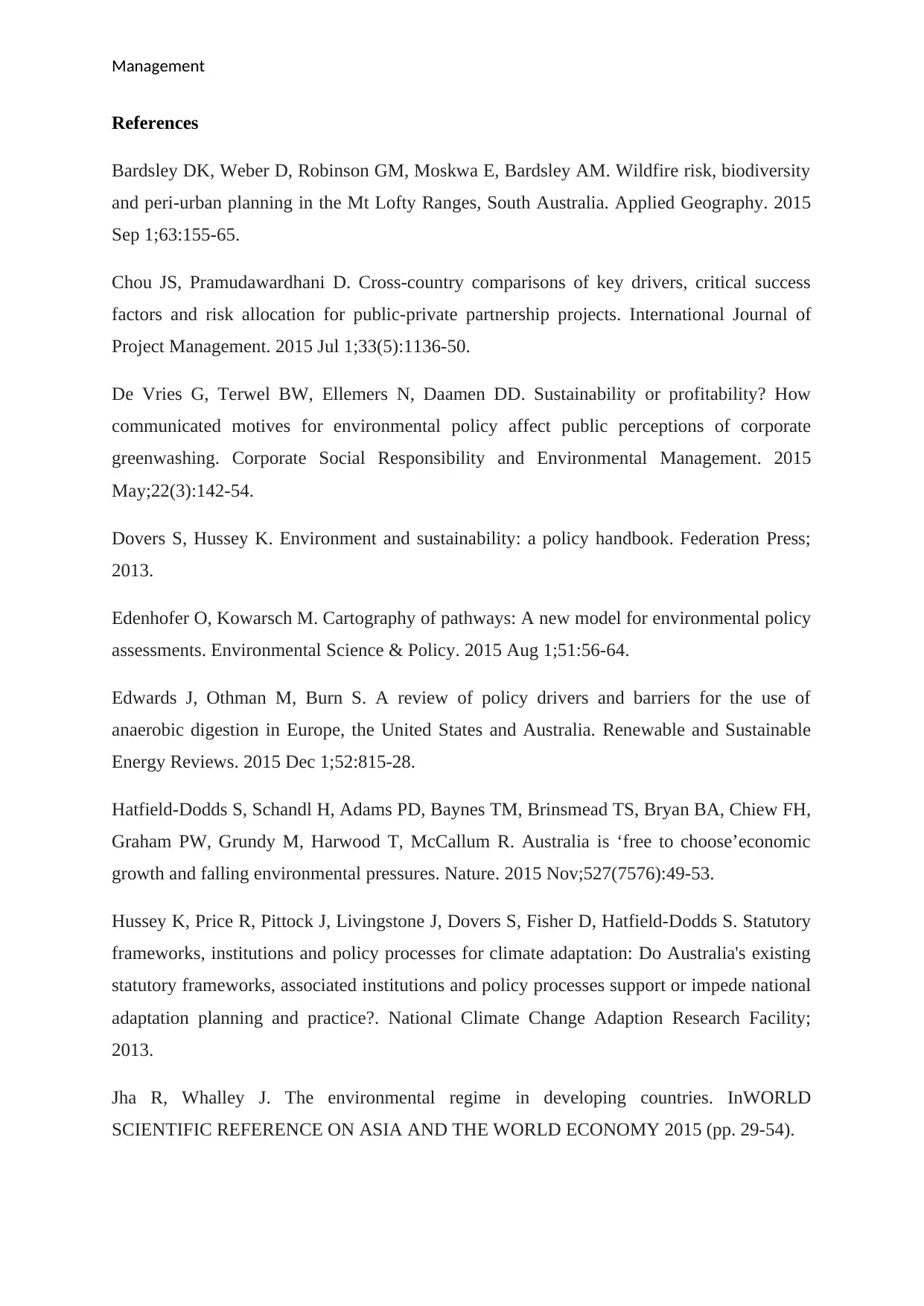
Management
References
Bardsley DK, Weber D, Robinson GM, Moskwa E, Bardsley AM. Wildfire risk, biodiversity
and peri-urban planning in the Mt Lofty Ranges, South Australia. Applied Geography. 2015
Sep 1;63:155-65.
Chou JS, Pramudawardhani D. Cross-country comparisons of key drivers, critical success
factors and risk allocation for public-private partnership projects. International Journal of
Project Management. 2015 Jul 1;33(5):1136-50.
De Vries G, Terwel BW, Ellemers N, Daamen DD. Sustainability or profitability? How
communicated motives for environmental policy affect public perceptions of corporate
greenwashing. Corporate Social Responsibility and Environmental Management. 2015
May;22(3):142-54.
Dovers S, Hussey K. Environment and sustainability: a policy handbook. Federation Press;
2013.
Edenhofer O, Kowarsch M. Cartography of pathways: A new model for environmental policy
assessments. Environmental Science & Policy. 2015 Aug 1;51:56-64.
Edwards J, Othman M, Burn S. A review of policy drivers and barriers for the use of
anaerobic digestion in Europe, the United States and Australia. Renewable and Sustainable
Energy Reviews. 2015 Dec 1;52:815-28.
Hatfield-Dodds S, Schandl H, Adams PD, Baynes TM, Brinsmead TS, Bryan BA, Chiew FH,
Graham PW, Grundy M, Harwood T, McCallum R. Australia is ‘free to choose’economic
growth and falling environmental pressures. Nature. 2015 Nov;527(7576):49-53.
Hussey K, Price R, Pittock J, Livingstone J, Dovers S, Fisher D, Hatfield-Dodds S. Statutory
frameworks, institutions and policy processes for climate adaptation: Do Australia's existing
statutory frameworks, associated institutions and policy processes support or impede national
adaptation planning and practice?. National Climate Change Adaption Research Facility;
2013.
Jha R, Whalley J. The environmental regime in developing countries. InWORLD
SCIENTIFIC REFERENCE ON ASIA AND THE WORLD ECONOMY 2015 (pp. 29-54).
References
Bardsley DK, Weber D, Robinson GM, Moskwa E, Bardsley AM. Wildfire risk, biodiversity
and peri-urban planning in the Mt Lofty Ranges, South Australia. Applied Geography. 2015
Sep 1;63:155-65.
Chou JS, Pramudawardhani D. Cross-country comparisons of key drivers, critical success
factors and risk allocation for public-private partnership projects. International Journal of
Project Management. 2015 Jul 1;33(5):1136-50.
De Vries G, Terwel BW, Ellemers N, Daamen DD. Sustainability or profitability? How
communicated motives for environmental policy affect public perceptions of corporate
greenwashing. Corporate Social Responsibility and Environmental Management. 2015
May;22(3):142-54.
Dovers S, Hussey K. Environment and sustainability: a policy handbook. Federation Press;
2013.
Edenhofer O, Kowarsch M. Cartography of pathways: A new model for environmental policy
assessments. Environmental Science & Policy. 2015 Aug 1;51:56-64.
Edwards J, Othman M, Burn S. A review of policy drivers and barriers for the use of
anaerobic digestion in Europe, the United States and Australia. Renewable and Sustainable
Energy Reviews. 2015 Dec 1;52:815-28.
Hatfield-Dodds S, Schandl H, Adams PD, Baynes TM, Brinsmead TS, Bryan BA, Chiew FH,
Graham PW, Grundy M, Harwood T, McCallum R. Australia is ‘free to choose’economic
growth and falling environmental pressures. Nature. 2015 Nov;527(7576):49-53.
Hussey K, Price R, Pittock J, Livingstone J, Dovers S, Fisher D, Hatfield-Dodds S. Statutory
frameworks, institutions and policy processes for climate adaptation: Do Australia's existing
statutory frameworks, associated institutions and policy processes support or impede national
adaptation planning and practice?. National Climate Change Adaption Research Facility;
2013.
Jha R, Whalley J. The environmental regime in developing countries. InWORLD
SCIENTIFIC REFERENCE ON ASIA AND THE WORLD ECONOMY 2015 (pp. 29-54).
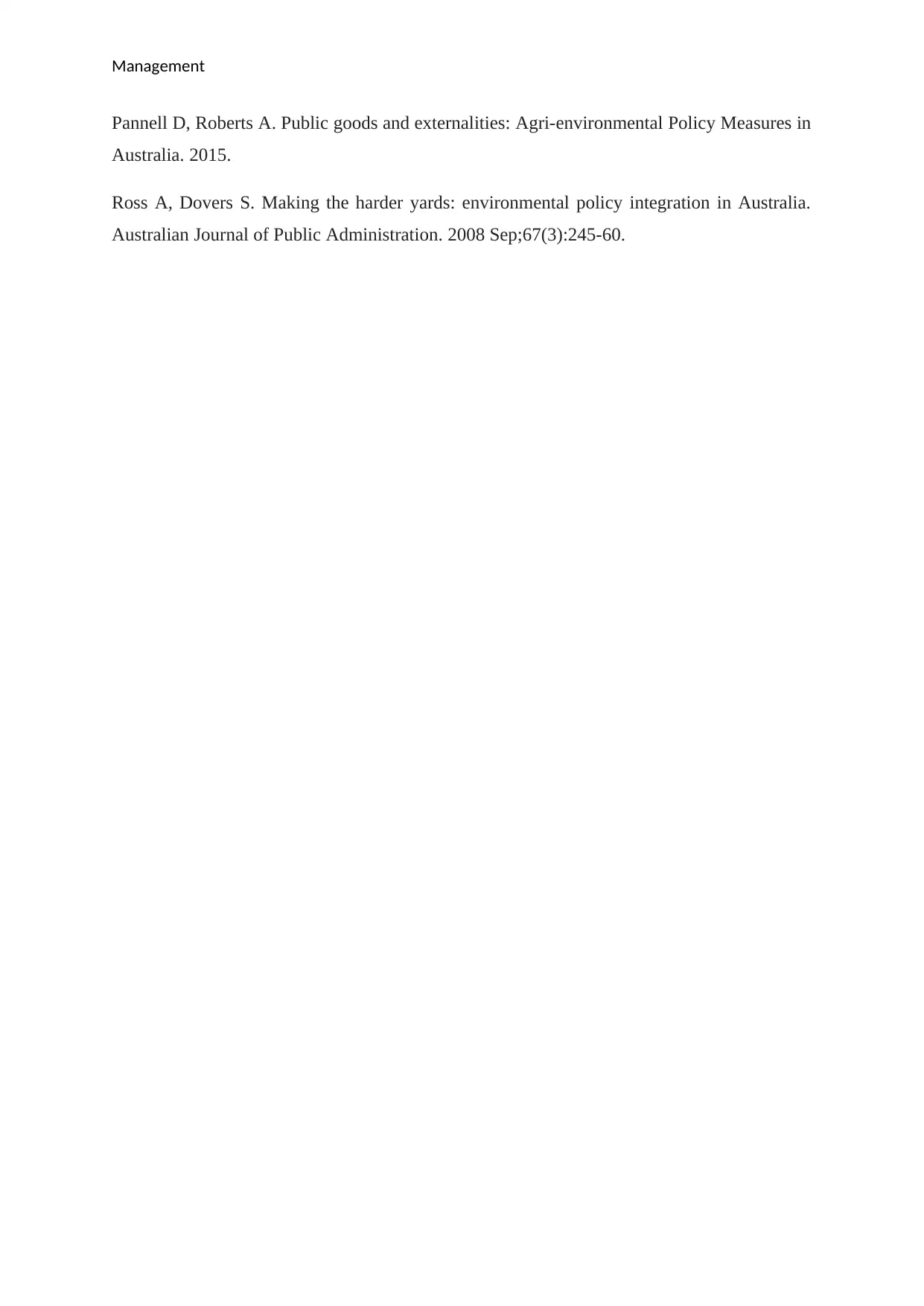
Management
Pannell D, Roberts A. Public goods and externalities: Agri-environmental Policy Measures in
Australia. 2015.
Ross A, Dovers S. Making the harder yards: environmental policy integration in Australia.
Australian Journal of Public Administration. 2008 Sep;67(3):245-60.
Pannell D, Roberts A. Public goods and externalities: Agri-environmental Policy Measures in
Australia. 2015.
Ross A, Dovers S. Making the harder yards: environmental policy integration in Australia.
Australian Journal of Public Administration. 2008 Sep;67(3):245-60.
⊘ This is a preview!⊘
Do you want full access?
Subscribe today to unlock all pages.

Trusted by 1+ million students worldwide
1 out of 9
Related Documents
Your All-in-One AI-Powered Toolkit for Academic Success.
+13062052269
info@desklib.com
Available 24*7 on WhatsApp / Email
![[object Object]](/_next/static/media/star-bottom.7253800d.svg)
Unlock your academic potential
Copyright © 2020–2025 A2Z Services. All Rights Reserved. Developed and managed by ZUCOL.





